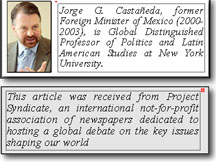MEXICO CITY – US President Barack Obama’s current swing through Latin America will probably be short on substance, long on rhetorical flourishes and symbolism, and may include a few announcements affecting American business in the region. More importantly, he will see real success stories, and how Latin America as a whole has changed.
The main change is that Latin America is splitting in two. Indeed, this might be the last trip that a US president ever makes to “Latin America.” Later visits will be either to South America, or to Mexico and the Caribbean Basin.
Chile’s success is old, if still inspiring, news. More than two decades of democratic rule and economic growth practically ensure that, simply by staying the course, the country will achieve lower-tier developed status by 2020.
And there is every reason to believe that it will stay the course, even if President Sebastián Piñera, who will preside over Chile’s best economic performance in 15 years, is succeeded by former president and rival Michele Bachelet in 2014. Even the country’s proverbial inequality is beginning to shrink, albeit slowly, and lower-middle-class living standards are finally rising to where they should have been a decade ago.
Brazil’s success is also well known. Millions of families have been lifted out of poverty. Inequality has diminished, though from astronomically high levels. The economy is growing at a sustainable pace. As long as China and India maintain their insatiable appetite for commodities, Brazil’s exports will finance today’s consumer boom.
In the international arena, the new president, Dilma Roussef, has pulled back from Luiz Inácio Lula Da Silva’s many excesses (indifference to human rights abuses, support for Iran and its nuclear programme, and rhetorical anti-Americanism) during his last year in office, and may even have a present for Obama. Brazil has been mulling whom to pick to renew its Air Force’s fighter fleet, and, whereas Lula favoured France, Roussef canceled that option and may be leaning toward the US.
El Salvador is Latin America’s most interesting success story. It is far from a picture of health and stability, with high levels of violence and crime, mass emigration, a slow-growth economy, and perpetual tensions within its centre-left coalition government. But next year the country will celebrate the 20th anniversary of the Chapultepec Peace Accords, which ended its decade-long civil war. Ever since, a country that had never truly experienced democratic rule has enjoyed all the charms and vicissitudes of competitive elections, legislative battles, and rotation in power.
 After a succession of conservative governments, in 2009 Salvadorans elected a president running on the ticket of the FMLN, the old guerrilla group that fought the Salvadorean army and its US ally to a draw in the late 1980s. The right accepted its defeat, and the left has governed reasonably (maintaining the dollar as the national currency). The right has started to regroup, and Obama will surely point to this virtuous cycle as one in which the US has played a positive role, and can continue to do so.
After a succession of conservative governments, in 2009 Salvadorans elected a president running on the ticket of the FMLN, the old guerrilla group that fought the Salvadorean army and its US ally to a draw in the late 1980s. The right accepted its defeat, and the left has governed reasonably (maintaining the dollar as the national currency). The right has started to regroup, and Obama will surely point to this virtuous cycle as one in which the US has played a positive role, and can continue to do so.
This would be even more true if the US were to move toward immigration reform. El Salvador, together with Ecuador, leads the world in terms of the proportion of its population living abroad. It also has an economy that is not growing sufficiently to stem the ongoing tide passing through Mexico to the US. Stagnant growth and emigration are two of the main factors causing division in the Americas. South America is booming, as India and China swallow up its exports of iron, copper, soybeans, coffee, coal, oil, wheat, poultry, beef, and sugar. Its foreign trade and investment patterns are diversified and dynamic. With a few minor exceptions, migration is internal to the region, and a modus vivendi has been reached with the drug trade, mainly coca leaf and cocaine in Bolivia, Peru, and Colombia.
Moreover, relations with the US, while important, are no longer paramount. South American governments can afford to disagree with the US, and often do. They have just elected a new president of the Union of South American Nations (Unasur), whose headquarters are being built in Quito, Equador. As its name suggests, Unasur’s main raison d’être is to exclude Canada, the US, and Mexico (in contrast to the Organization of American States).
None of this holds true for Mexico, Central America, and the Caribbean islands – mainly the Dominican Republic, but eventually Cuba, too, and, in its own way, Haiti. These are not mineral-rich or bountiful agricultural nations: some coffee and bananas here, a little sugar and beef there, but nothing with which to sustain a boom. While Mexico is America’s second-largest supplier of oil, this represents only 9% of its total exports.
Instead, these countries export low-value-added manufactured goods (Mexico does more, of course), and live off remittances, tourism, and drug-transhipment profits. All of this is overwhelmingly concentrated on the US: that is where the migrants are, where the towels and pajamas are shipped, where the tourists come from, and where the drugs are bought. For these countries, including Mexico, stable, close, and productive relations with America are essential.
Obama will say all the right things during his visit, and will be cheered everywhere. But he should ponder the shifts taking place in the hemisphere. One area is freeing itself from US hegemony and is thriving, but may founder if Chinese and Indian growth slows. Another is increasingly integrated with the US and Canada. Despite its current travails, it will discover a path to prosperity when the US does.
Latin America as a single entity is no more. Long live Latin America.








